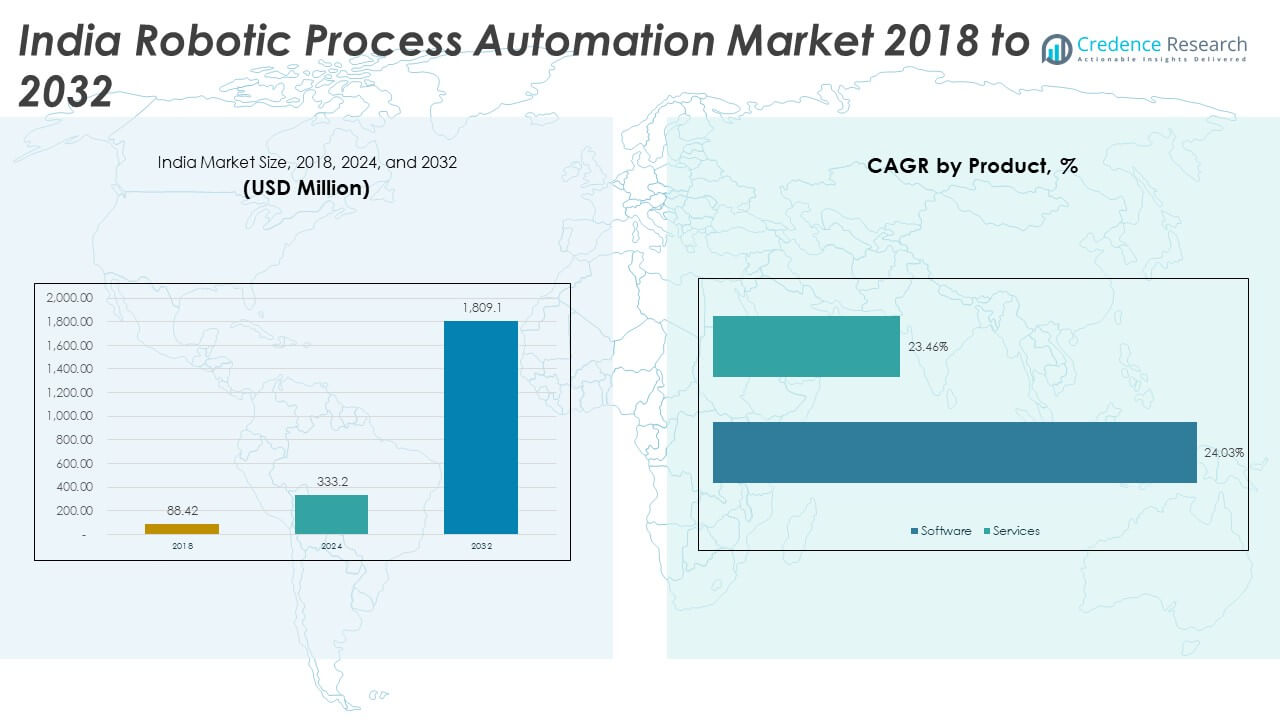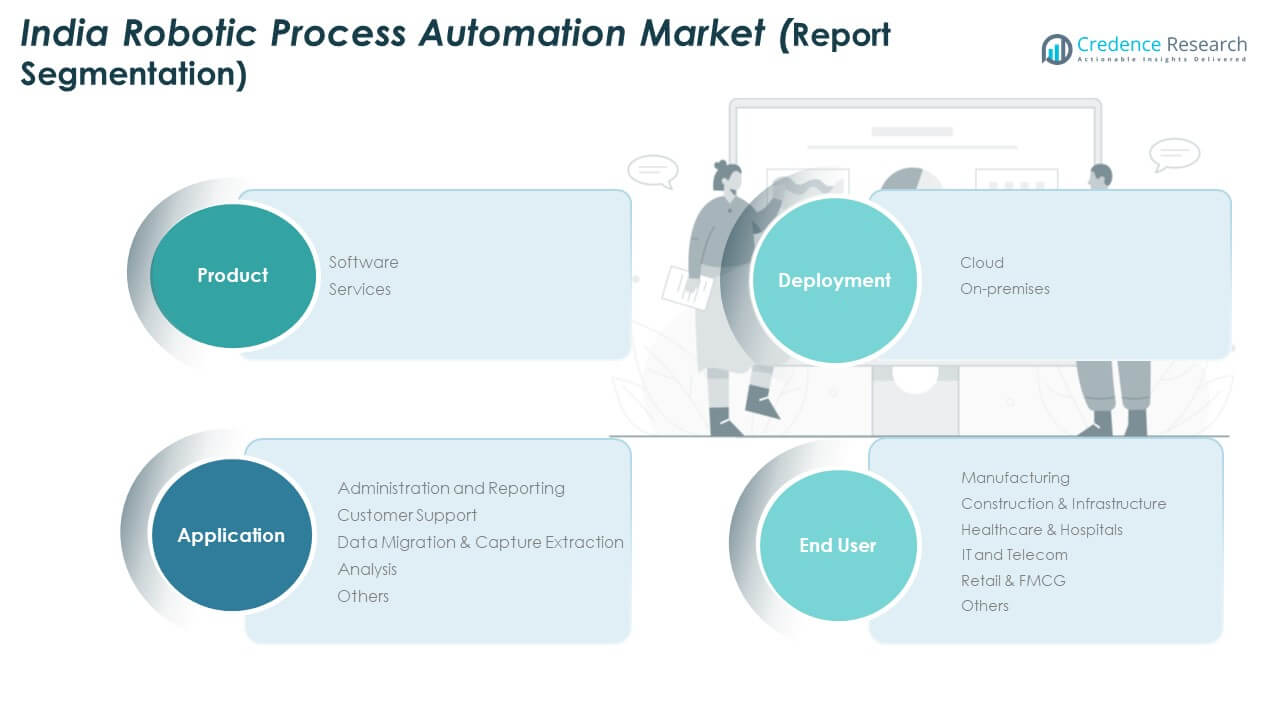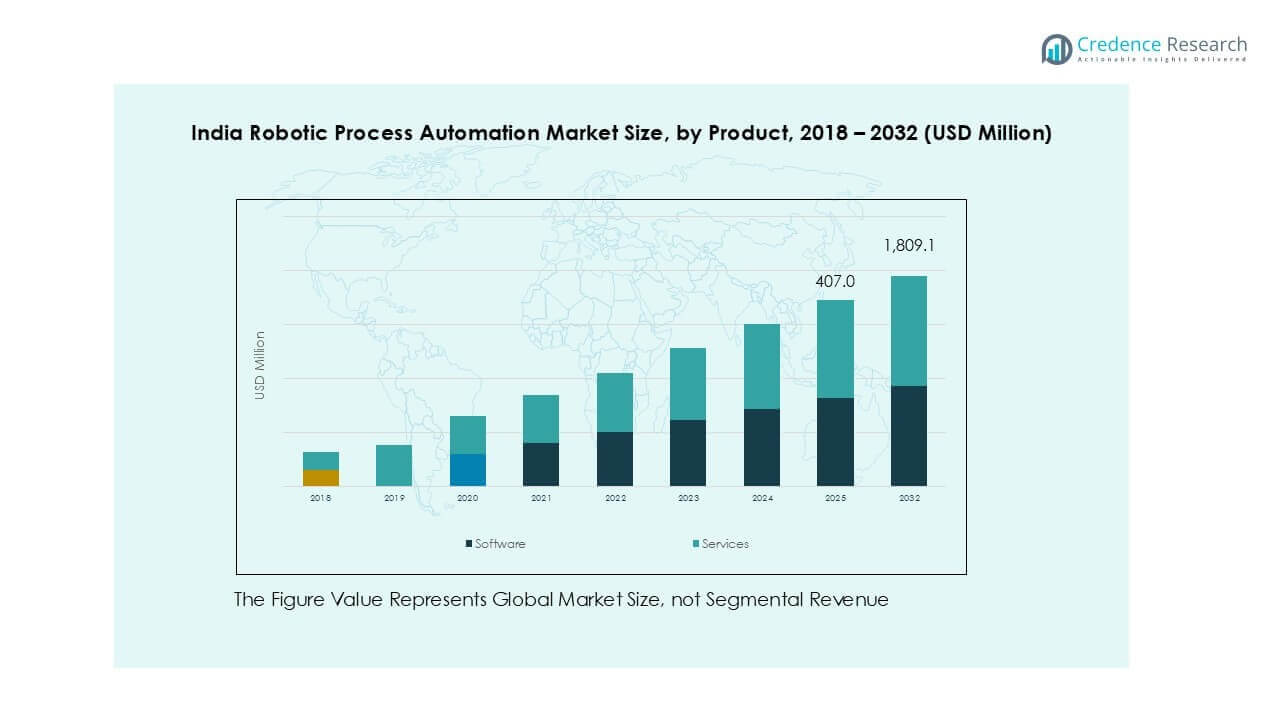Market Overview
India Robotic Process Automation (RPA) Market size was valued at USD 88.42 million in 2018, grew to USD 333.2 million in 2024, and is projected to reach USD 1,809.1 million by 2032, registering a CAGR of 23.55% during the forecast period.
| REPORT ATTRIBUTE |
DETAILS |
| Historical Period |
2020-2023 |
| Base Year |
2024 |
| Forecast Period |
2025-2032 |
| India Robotic Process Automation (RPA) Market Size 2024 |
USD 333.2 Million |
| India Robotic Process Automation (RPA) Market, CAGR |
23.55% |
| India Robotic Process Automation (RPA) Market Size 2032 |
USD 1,809.1 Million |
The India Robotic Process Automation (RPA) market is led by major players such as UiPath, Automation Anywhere, SS&C Blue Prism, IBM, EdgeVerve, and Datamatics, which together account for a significant share of deployments. These companies offer AI-enabled platforms, scalable automation solutions, and cloud-based RPA tools, catering to large enterprises and SMEs. North India dominates with 35% market share, driven by strong BFSI and IT/ITES adoption in Delhi-NCR and Gurugram. West India follows with 28% share, supported by financial hubs in Mumbai and Pune, while South India holds 25% share due to its large IT/BPM base.
 Market Insights
Market Insights
- India’s RPA market was valued at USD 333.2 million in 2024 and is projected to reach USD 1,809.1 million by 2032, registering a CAGR of 23.55% during the forecast period.
- Growth is driven by rising digital transformation, IT/BPM sector adoption, and demand for cost efficiency. Enterprises are automating reporting, payroll, and customer support tasks to reduce manual effort and errors.
- Key trends include integration of AI and ML for cognitive automation, expansion of cloud-based RPA for scalability, and growing adoption by SMEs and government agencies for e-governance and citizen services.
- The competitive landscape features UiPath, Automation Anywhere, SS&C Blue Prism, IBM, and domestic players like Datamatics and EdgeVerve, focusing on low-code platforms, partnerships, and vertical-specific solutions.
- North India holds 35% market share, West India 28%, South India 25%, and East India 12%, with software segment leading product adoption followed by services support and managed solutions.
Access crucial information at unmatched prices!
Request your sample report today & start making informed decisions powered by Credence Research Inc.!
Download Sample
Market Segmentation Analysis:
By Product
The software segment dominates the RPA market, accounting for over 65% of revenue share in 2024. High demand for advanced automation platforms and AI-driven bots drives adoption across industries. Software solutions enable faster process design, orchestration, and scaling, which reduces operational costs. Continuous innovations, such as low-code and no-code interfaces, support easier deployment for non-technical users. The services segment, though smaller, is growing rapidly as enterprises seek consulting, training, and managed services to optimize automation outcomes and maintain compliance with industry regulations.
- For instance, UiPath reported an annual recurring revenue (ARR) of over USD 1.45 billion in fiscal year 2024, specifically reaching $1.464 billion in the fourth quarter ending January 31, 2024.
By Application
Administration and reporting is the leading application segment, holding more than 35% share in 2024. Businesses use RPA to streamline repetitive reporting tasks, reduce manual errors, and ensure regulatory compliance. Customer support automation is expanding with chatbots and AI assistants, enabling 24/7 resolution and lower support costs. Data migration and capture extraction also see strong demand in banking and healthcare, where accurate data transfer is critical. Analysis applications benefit from RPA’s integration with analytics tools, while the “others” category includes HR and procurement workflows gaining steady traction.
- For instance, Automation Anywhere has promoted new AI and automation features during 2024 and was recognized as a Leader in the Gartner Magic Quadrant for Automation. The company also publicized other achievements during the year, such as its generative AI-powered automation saving Petrobras $120 million in just three weeks.
By Deployment
Cloud deployment is the dominant model, representing over 60% of the market share in 2024. Organizations favor cloud-based RPA for its scalability, faster implementation, and lower upfront infrastructure costs. The growing adoption of hybrid work models and remote operations further boosts cloud demand. On-premises deployment remains relevant for industries with strict data security and compliance requirements, such as banking, defense, and healthcare. Vendors are increasingly offering hybrid solutions to combine the flexibility of cloud with the control of on-premises systems, catering to diverse enterprise needs.
Key Growth Drivers
Rising Digital Transformation Initiatives
India’s rapid adoption of digital transformation programs fuels RPA growth. Government-led initiatives such as Digital India and private sector investments push organizations to automate back-office functions and reduce manual effort. Enterprises in BFSI, telecom, and retail are using RPA to handle large volumes of data securely. Increased demand for operational efficiency, cost savings, and compliance further accelerates deployment. This shift supports scalable, AI-enabled automation platforms that streamline workflows and improve decision-making speed.
- For instance, Wipro implemented Robotic Process Automation (RPA) solutions for enterprise clients in 2024, leveraging AI and automation to enhance efficiency across various business functions, including finance and customer service.
Growing Adoption in IT and BPM Sector
The IT and BPM sectors dominate India’s RPA market, contributing a significant revenue share. Leading outsourcing firms use RPA to manage repetitive processes, including payroll, client onboarding, and reporting. Demand is rising for bots that integrate with ERP and CRM systems to improve process accuracy. This adoption reduces turnaround time and enhances client experience. As global enterprises outsource to India, service providers are expanding automation-led service offerings to remain competitive and increase profitability.
- For instance, Infosys is actively scaling its automation capabilities for global clients, leveraging a combination of Robotic Process Automation (RPA) and other technologies to improve efficiency. For example, Infosys BPM implemented an automation solution for a large client’s HR processes, which reduced average handling times by 55% and cut manual effort by 70%. This follows Infosys’s move in 2023 to train over 40,000 of its employees in generative AI to drive further technological transformation.
Cost Efficiency and Workforce Optimization
Indian enterprises are adopting RPA to reduce operational costs and optimize workforce allocation. RPA bots handle repetitive tasks, freeing employees for high-value analytical work. This improves productivity and reduces human error rates in data processing. Small and medium-sized businesses are also deploying RPA to scale without adding headcount. Lower implementation costs compared to developed markets make RPA accessible to a wider range of Indian businesses, driving market expansion across Tier 1 and Tier 2 cities.
 Key Trends & Opportunities
Key Trends & Opportunities
Integration of AI and Machine Learning
A major trend is the integration of AI and ML into RPA platforms, enabling cognitive automation. AI-powered bots can process unstructured data, perform sentiment analysis, and make predictive decisions. This trend is helping Indian businesses move from rule-based automation to intelligent automation, creating opportunities in sectors like healthcare, e-commerce, and insurance. Vendors are focusing on developing smarter bots that learn over time, improving process outcomes and delivering actionable business insights.
- For instance, in February 2024, at its DevCon event in Bengaluru, UiPath announced new developer features aimed at accelerating the implementation of automations. It also disclosed plans to equip 500,000 Indians with AI and automation skills by 2027 through its Academic Alliance program.
Expansion in SME and Government Adoption
The Indian SME sector presents strong growth opportunities as automation becomes affordable and scalable. Cloud-based RPA solutions allow smaller firms to automate invoice processing, HR, and compliance tasks without heavy IT investment. Government departments are also piloting RPA for citizen services, including tax processing and document verification. This growing demand from diverse sectors offers vendors a chance to expand their footprint and build industry-specific RPA solutions tailored to local needs.
- For instance, in 2025, the software company Automation Anywhere collaborated with the Akshaya Patra Foundation to enhance its mid-day meal program using AI and automation. NeGD, created in 2009 under the Ministry of Electronics & Information Technology, focuses on programme management, project development, technology management, and capacity building for Digital India initiatives.
Key Challenges
High Implementation and Maintenance Complexity
Despite its benefits, RPA adoption faces complexity challenges in India. Integration with legacy systems often requires additional customization, increasing deployment time and costs. Many organizations lack in-house expertise to manage bots, leading to dependence on third-party vendors. Ongoing maintenance and bot governance are critical to prevent errors or process breakdowns, which can raise total cost of ownership and delay ROI for enterprises adopting RPA solutions.
Workforce Resistance and Skill Gaps
Workforce resistance is a major barrier, with employees fearing job loss due to automation. Organizations must invest in reskilling programs and change management strategies to build trust. India also faces a shortage of skilled professionals capable of designing, deploying, and managing RPA bots at scale. This skill gap slows adoption for many mid-sized enterprises and restricts the ability to leverage full benefits of automation across complex workflows.
Regional Analysis
North India
North India leads the RPA market with around 35% share in 2024, driven by strong adoption across BFSI, IT services, and manufacturing hubs in Delhi-NCR, Haryana, and Uttar Pradesh. Enterprises focus on automating compliance-heavy processes, including reporting and payroll, to meet regulatory standards. Large IT firms and government-backed initiatives under Digital India are accelerating cloud-based deployments. The presence of major service providers and tech talent in Gurugram and Noida supports faster implementation, making the region a key contributor to overall RPA growth in the country.
West India
West India accounts for nearly 28% market share in the Indian RPA industry, with significant contributions from Maharashtra and Gujarat. Mumbai and Pune drive adoption through banking, financial services, and e-commerce sectors, which use RPA for customer onboarding and fraud detection. Gujarat’s growing industrial base leverages automation to improve supply chain efficiency. Availability of skilled IT professionals and proximity to major corporate headquarters enhance deployment rates. Increasing investments in AI-enabled automation by fintech firms and startups further support RPA market expansion across this region.
South India
South India holds about 25% share of the RPA market, fueled by its strong IT/ITES and BPM sector presence in Bengaluru, Hyderabad, and Chennai. Leading global outsourcing companies deploy RPA to manage large-scale back-office operations, boosting demand for scalable solutions. Cloud adoption is high due to robust data center infrastructure, enabling quick rollouts for SMEs. Collaboration between tech startups and multinational RPA vendors is driving innovation, creating AI-integrated bots for analytics, customer service, and healthcare applications, making the region a center for advanced automation development.
East India
East India captures approximately 12% share of the RPA market, representing a smaller but growing segment. Adoption is rising in Kolkata and Bhubaneswar, with BFSI, telecom, and public utilities leading the way. Regional enterprises are beginning to implement RPA for process optimization, data migration, and government e-services. Infrastructure development projects and increasing digital literacy are opening opportunities for vendors to expand offerings in Tier 2 and Tier 3 cities. Growing demand for affordable, cloud-based automation solutions positions this region as an emerging growth market in the coming years.
 Market Segmentations:
Market Segmentations:
By Product
By Application
- Administration and Reporting
- Customer Support
- Data Migration & Capture Extraction
- Analysis
- Others
By Deployment
By End User
- Manufacturing
- Construction & Infrastructure
- Healthcare & Hospitals
- IT / IT-enabled Services
- Retail & FMCG Corporates
- Others
By Geography
- North India
- West India
- South India
- East India
Competitive Landscape
The India RPA market is highly competitive, with global leaders and domestic players actively expanding their presence. UiPath, Automation Anywhere, and SS&C Blue Prism dominate with strong product portfolios, AI-integrated bots, and enterprise-grade platforms, holding a major share of enterprise deployments. IBM and EdgeVerve leverage their AI and analytics expertise to deliver cognitive automation solutions tailored for BFSI and IT/ITES clients. Domestic firms such as Datamatics, Core Integra, and NeoSOFT focus on cost-effective, customized implementations for SMEs and government projects. Vendors compete on scalability, ease of deployment, and pricing models, with increasing emphasis on cloud-based and low-code solutions. Strategic partnerships with IT service providers, technology alliances, and localized training programs are strengthening market penetration. Recent developments include collaborations with consulting firms, industry-specific automation offerings, and expansion of partner ecosystems to tap mid-market demand, positioning players for strong growth through 2032.
Shape Your Report to Specific Countries or Regions & Enjoy 30% Off!
Key Player Analysis
- UiPath
- Core Integra
- SS&C Blue Prism
- Automation Anywhere
- IBM
- CIGNEX
- EdgeVerve
- Datamatics
- deltAlyz Corp
- NeoSOFT
- Other Key Players
Recent Developments
- In December 2024, UiPath partnered with the UAE government’s AI, Digital Economy, and Remote Work End Uses Office to advance Agentic Automation, an AI-powered approach to automation. The collaboration aims to develop AI-driven solutions across government entities while equipping UAE talent with essential AI skills. Aligned with the UAE’s National AI Strategy, the initiative includes creating an automation and AI training program for up to 100 students and government employees. UiPath also supports the upskilling of members in Coders HQ, part of the National Program for Coders Initiatives.
- In November 2024, Automation Anywhere Inc. announced a strategic partnership with PwC India, a Business Consulting and Services provider to help enterprises enhance efficiency through GenAI-powered automation solutions. This collaboration combines Automation Anywhere Inc.’s advanced technology with PwC India’s industry knowledge and consulting expertise. The partnership focuses on developing generative AI-based automation solutions aimed at transforming key business operations across various sectors, including financial services, retail & consumer, and healthcare.
Report Coverage
The research report offers an in-depth analysis based on Product, Application, Deployment, End User and Geography. It details leading market players, providing an overview of their business, product offerings, investments, revenue streams, and key applications. Additionally, the report includes insights into the competitive environment, SWOT analysis, current market trends, as well as the primary drivers and constraints. Furthermore, it discusses various factors that have driven market expansion in recent years. The report also explores market dynamics, regulatory scenarios, and technological advancements that are shaping the industry. It assesses the impact of external factors and global economic changes on market growth. Lastly, it provides strategic recommendations for new entrants and established companies to navigate the complexities of the market.
Future Outlook
- Adoption of RPA will accelerate across BFSI, healthcare, and manufacturing due to rising automation needs.
- Cloud-based RPA platforms will dominate as enterprises seek scalable and cost-efficient solutions.
- AI and ML integration will enhance bots’ ability to process unstructured data and make predictive decisions.
- SMEs will increasingly adopt RPA to automate HR, compliance, and invoicing tasks at lower costs.
- Hybrid deployment models will gain traction to balance data security with cloud flexibility.
- Demand for low-code and no-code RPA platforms will rise, empowering non-technical business users.
- RPA vendors will expand partnerships with IT service providers to deliver end-to-end automation solutions.
- Industry-specific RPA use cases will grow, especially in telecom, e-commerce, and government services.
- Training and reskilling programs will become critical to address India’s automation skill gap.
- Regional adoption will expand into Tier 2 and Tier 3 cities, driving broader market penetration.

 Market Insights
Market Insights Key Trends & Opportunities
Key Trends & Opportunities Market Segmentations:
Market Segmentations:





